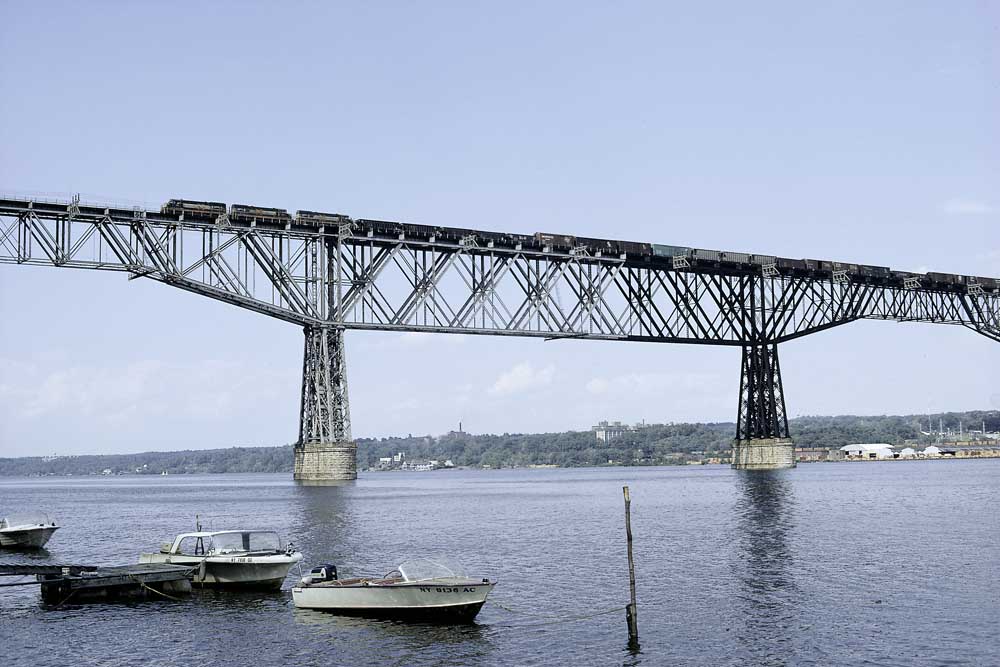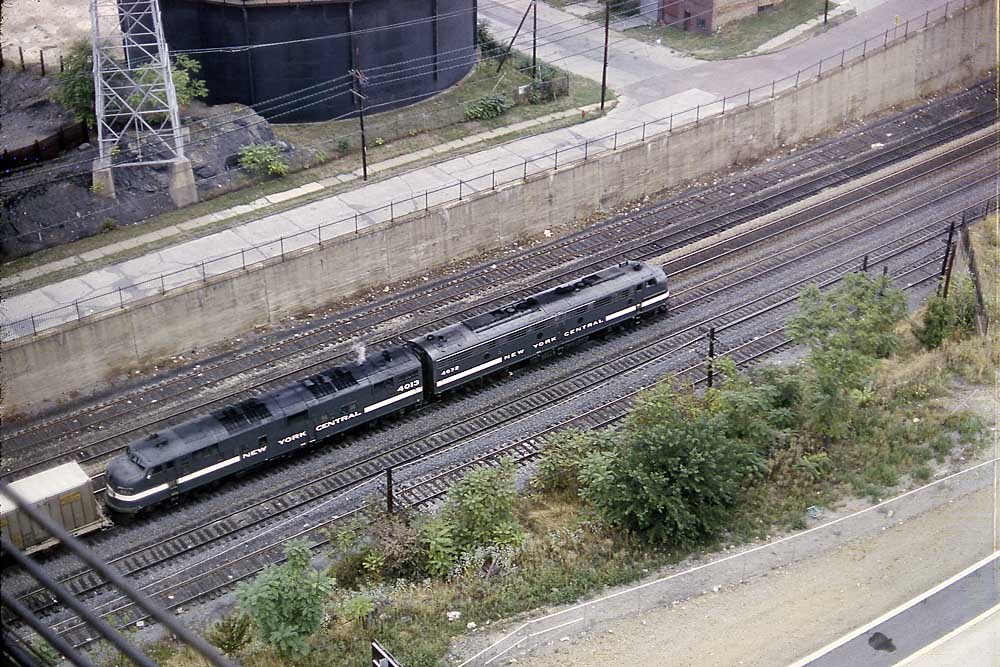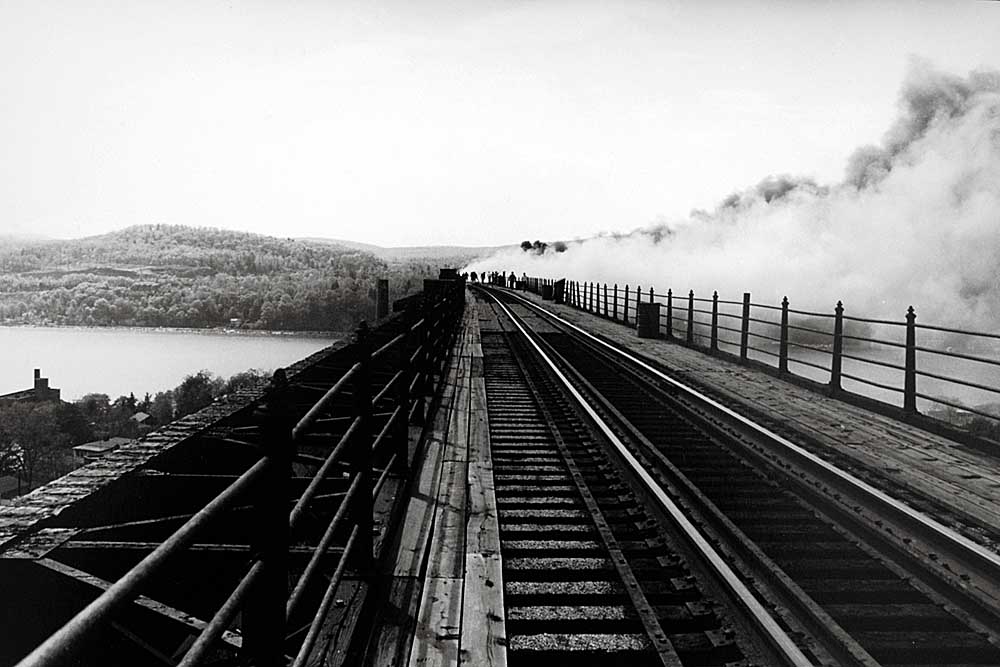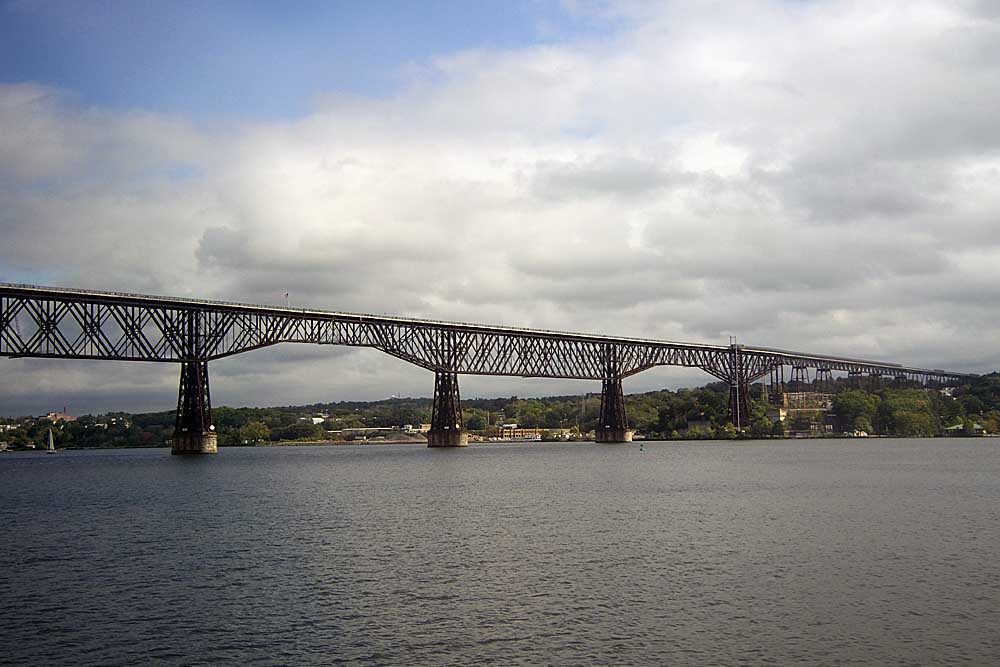The Walkway Over the Hudson state park has an illustrious railroad history dating back to the opening of the massive Poughkeepsie Bridge at Poughkeepsie, N.Y., in 1889.

From its creation in 1872 until it was merged into the Penn Central 97 years later, the New York, New Haven & Hartford Railroad (familiarly known as the New Haven) dominated transportation in southern New England. The result of the combination of more than 200 earlier railroads, the New Haven stretched from Boston and the tip of Cape Cod across Rhode Island and Connecticut to reach New York City and the upper New York State.
New England was an industrial giant, and the New Haven handled freight to and from the north via the Boston & Maine and Central Vermont, to the west on New York Central’s Boston & Albany, and to various mid-Atlantic railroads via carfloats across New York Harbor. But its most important freight interchanges to the West and South were in the small village of Maybrook, N.Y., about 60 miles north of Manhattan.
At Maybrook and nearby Campbell Hall, the New Haven interchanged with Erie Railroad’s main line to Chicago, with the 90-mile bridge route Lehigh & Hudson River, and anthracite carriers Lehigh & Hudson River and New York, Ontario & Western. The latter two fed hard coal to New England factories and homes. L&HR allowed freight to flow between NH points and Lehigh Valley, Jersey Central, Pennsylvania, and Reading in the Phillipsburg, N.J./Allentown (Pa.) region.
New Haven’s 125-mile Maybrook Route began at the giant Cedar Hill Yard in New Haven, Conn., and used the railroad’s electrified main line west 14 miles to Devon and made a quick 8-mile-run north on NH’s Naugatuck Valley Line. At Derby Junction, NH freights entered the actual Maybrook line, running 74 miles to the large yard in tiny Maybrook. The highlight of the line was the bridge over the Hudson River at Poughkeepsie. Towering 212 feet over the river, the seemingly spindly steel structure stretched 6,768 feet in length.

Built by Philadelphia interests to funnel anthracite into New England, the bridge came under New Haven’s control in 1904, when the railroad purchased the Central New England Railway, which was merged into the parent company in 1927. The Poughkeepsie bridge opened with two separate tracks; a gantlet arrangement was implemented in 1918. That lasted until 1958, when a centralized traffic control project removed most of the second track over the length of the Maybrook Route, leaving just one track over the bridge. Throughout most of its history, trains tiptoed across the structure at a maximum of 12 mph.
New Haven’s 50 Class L-1 Alco 2-10-2s ruled the route from 1919 until replaced by three-unit sets of Alco-GE FA/B1s in 1947. The big Santa Fe-type steam locomotives had been purchased to handle freight systemwide, but with 63-inch drivers they weren’t fast enough to keep out of the way of frequent high-speed passenger trains on the main lines. They quickly found a home on the Maybrook. Even with all their tractive effort, the L-1 required a rear-end pusher (usually another 2-10-2) on the stiff eastbound grade from Hopewell Junction, N.Y. Their streamlined Alco diesel successors held down most trains on the route for a decade, being joined by EMD GP9s, Alco RS11s, and Fairbanks-Morse H16-44s beginning in 1956. New Haven’s final new diesels, 26 GE U25Bs and 10 Alco C425s, took over Maybrook trains beginning in 1964.
The Maybrook route lost business as New England used less anthracite, but the route remained very busy. The line was essential throughout World War II. New Haven historian J. W. Swanberg’s definitive book New Haven Power (Alvin F. Staufer, 1988) reported that the bridge carried a record 53 trains, with 3,491 cars, on March 20, 1943. Do the math: That’s a train rolling onto the bridge every 27 minutes!
Peace did not translate to prosperity for the New Haven route. Anthracite traffic dwindled, and Maybrook connection New York, Ontario & Western shut down in 1957, followed four years later when Lehigh & New England quit. Much of New England’s major industry left the region or shut down entirely through the postwar period. During New Haven’s final years, the route was down to about four trains a day in each direction, connecting with Erie Lackawanna or Lehigh & Hudson River at increasingly quiet Maybrook.
It got worse. New Haven was merged into the new Penn Central on Jan. 1, 1969, and the big railroad quickly shifted most of NH’s freight to its former New York Central/Boston & Albany route. Within a few months, New Haven’s busy New York harbor carfloat operations were shut down. And Maybrook traffic dropped to a trickle, finally just one daily train in each direction.

May 8, 1974, marked the end of the Maybrook route, as a major fire attributed to a passing Penn Central freight severely damaged large portions of the bridge’s east end. Although bankrupt PC was in no position to rebuild the bridge, the railroad and New York state worked to arrange financing. In the meantime, most of the route between Maybrook and Hopewell Junction, N.Y., was quickly mothballed. East of Hopewell Junction survived, as Penn Central (and later, Conrail) used another old New Haven line from Hopewell Junction to Beacon, where freight could use the former NYC Hudson Line to reach the giant Selkirk Yard near Albany.
Penn Central’s inclusion in the new government-funded Conrail in 1976 provided more hope that the Poughkeepsie Bridge would be repaired to reopen the Maybrook route. But PC had already demonstrated it did not need Maybrook, and the new Conrail was shedding much-busier duplicative main lines. Although the bridge was listed on the National Register of Historic Places in 1979, trains never returned. By the mid-1980s, virtually all the Maybrook route trackage between Hopewell Junction and Maybrook would be removed. Conrail would continue to use the Maybrook Line and the Beacon branch for some Selkirk freight until 1993, when Derby Junction-Danbury-Hopewell Junction-Beacon (essentially all remaining active Maybrook route trackage) was sold to the Housatonic Railroad.
There was little freight business west of Danbury, and within a few years Metro-North Commuter Railroad purchased Housatonic’s trackage from the Connecticut/New York state line to Beacon. Although it had been suggested parts of the route might someday be used for commuter trains, its only purpose was for occasional equipment moves between Danbury and Metro-North’s shops on the railroad’s Harlem Line at North Brewster. The line currently is up for abandonment, although local leaders in Danbury have proposed rebuilding tracks to Brewster, hoping to cut a few minutes of travel time by operating some Metro-North Danbury-New York City passenger trains via MN’s Harlem Line. In 2022, the only active segments of the Maybrook Route are Housatonic’s tracks between Danbury and Derby Junction, and a short piece at Maybrook operated by the Middletown & New Jersey.

Today, the former Maybrook Route right of way through New York state hosts several trails, with several names, mostly interconnected, all part of the Empire State Trail. Since 2009, the crown jewel of the trail system is Walkway Over the Hudson State Historic Park, which provides the opportunity for 600,000 visitors each year to walk the length of the Poughkeepsie Bridge.
The deteriorating bridge stood had stood empty for a decade when Conrail sold it to a non-rail entity in 1984. Title to the bridge passed through other owners until it was deeded to nonprofit Walkway Over the Hudson in 1998. Over the following 11 years, the organization raised more than $30 million to rehabilitate the bridge to create a 1.28-mile public walkway. Today the bridge is owned and maintained by the New York State Bridge Authority, and is operated by the state’s Office of Parks, Recreation and Historic Preservation. Visitors can access the walkway at bridge level from the west end in Highland, N.Y., or use an elevator from ground level in Poughkeepsie.














The bridge provided a way for the Erie Lackawanna to offer Chicago-New England freight service–something not in the Penn Central’s interest. They also wanted to rid the New Haven of as much freight as possible so they could unload the railroad on the government while keeping the freight–hence the discontinuance of the car float service. All freight to Boston from the south and west would thus have to go through Selkirk and the Boston & Albany route once the bridge was out of service–and it thus very conveniently caught fire.
I have walked over this bridge several times, and, if you have not done it, it is very much worth the effort. The views are astonishing, and you can watch trains on both sides of the Hudson form this vantage point.
It’s rumored that Penn Central sabotaged the bridge as a way of abandoning the route without jumping through regulatory hoops. Again, just a rumor.